Amazon Fire TV Stick vs Chromecast 2 vs Roku Streaming Stick
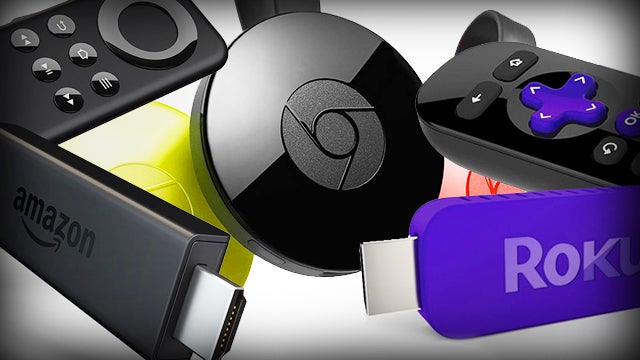
Which is the best media streaming stick to buy? We compare the Amazon Fire TV Stick with Google’s Chromecast 2 and the Roku Streaming Stick.
Streaming media content to your TV has never been easier or cheaper. Just plug a little device into one of your TV’s HDMI ports, and you’ve stepped into a world of streaming goodness.
Google’s Chromecast 2, the Roku Streaming Stick and Amazon’s Fire TV Stick have been providing low-cost streaming kicks for a while now, helping us make our dumb TVs smart, for substantially less than £50.
While higher-priced boxes are available from the likes of Asus with its Nexus Player, as well as Apple and Amazon, those sub-£50 sticks are a much better solution if all you want to do is binge on some Netflix, catch up with iPlayer and listen to music through your television.
Yes, they aren’t quite as suitable for gaming – though all do have access to light games – but we’d always suggest a dedicated gaming console for this anyway.
So which cut-price media-streaming stick is best? Let’s take a look at what each has to offer.
Amazon Fire TV Stick vs Chromecast 2 vs Roku Streaming Stick: Design and Remote
The Amazon Fire TV Stick and the Roku Streaming Stick sport similar designs – they’re compact sticks that plug into your TV’s HDMI port. They all resemble old-fashioned USB sticks or mobile internet dongles.
Related: Best VPNs for streaming video
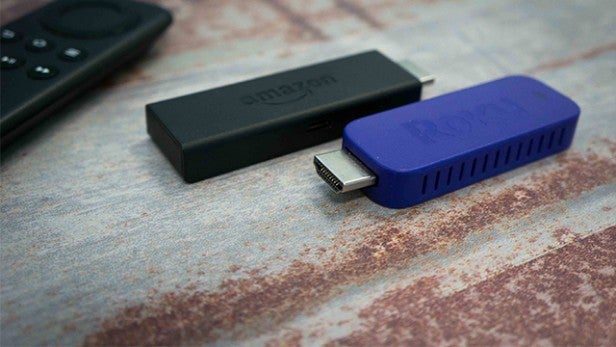
The original Chromecast was also like this, but the second and latest model takes on a disk shape, and connects to your TV with a short USB chord. This is actually better than the other two in terms of compatibility, as it fits in any TV with an HDMI port, whereas some TVs don’t work well with the stick approach.
Roku has injected a bit of its characteristic purple colour into the Streaming Stick, while Amazon added a nice dimply texture to its Fire TV Stick. But design is hardly an important factor here, as each will sit behind your screen, completely out of view.
One thing that’s worth pointing out is that all three require external powering, so you’ll have to attach a Micro USB cable and plug it into the mains. This does dilute the simplicity factor somewhat, but it’s definitely not a deal-breaker.
SEE ALSO: Amazon Fire TV
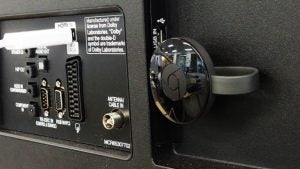
As the Amazon and Roku units are fairly nondescript, it puts more focus on the design and functionality of the remote. Both come with one, and very decent they are too. We’d always prefer to control something with a physical press rather than a virtual one. As we’ll mention shortly, however, a remote wouldn’t really suit the Chromecast 2.
Unlike the fully powered Fire TV’s remote, the standard controller that comes with the Stick doesn’t have any nifty voice-control tech, which is a shame. You can specify one when you come to buy the stick, for an extra £10, or instead use the pretty acceptable app for all your voice-control needs.
Again, the Roku remote loses some of the more ‘premium’ features of its pricier siblings. There’s no headphone jack, for example, but we can’t be too bitter at this price point.
Amazon Fire TV Stick vs Chromecast 2 vs Roku Streaming Stick: Performance and Specs
If it’s a powerful stick you’re after, the Amazon Fire TV sprints out into a comfortable lead here. Its dual-core CPU is about six times more powerful than the Roku Streaming Stick’s single-core equivalent, and its 1GB of RAM is double that of both its rivals. It also boasts 8GB of storage – 32 times more than the piddly 256MB offered in its rivals.
SEE ALSO: What to watch on Amazon Prime Video
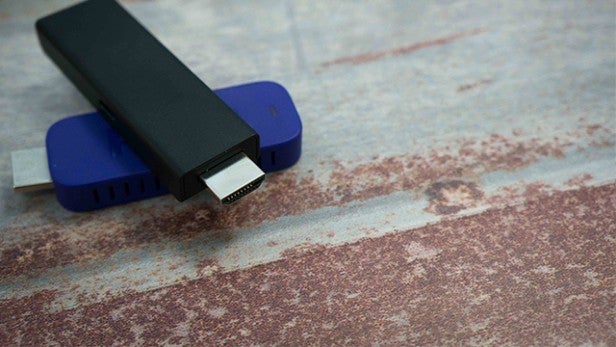
Of course, these are streaming sticks, so that’s not too much of an issue with storage, but the Fire TV Stick’s extra capacity is useful for its ASAP service, as we’ll discuss in a bit.
The point is, the Amazon device’s extra performance headroom shows.
Performance on the Fire TV Stick is leaps and bounds ahead of the competition. Scrolling through the interface is snappy, jumping to and from apps is on-point and videos seem to load almost instantaneously. That last point might have Amazon’s ASAP feature to thank, as this is meant to understand the types of things you’re most likely to watch and pre-buffer them before you settle in for a binging session.
Buy Now: Amazon Fire TV Stick at Amazon
On the Roku Streaming Stick we were met with a much slower interface that often froze, stumbled and seemed to struggle with even the easiest task. Downloading apps always gave us a few seconds of complete inoperability and opening them up took what seemed like a few seconds. In fact it was less, but the slow splash screens made it seem like we were waiting much longer than we should.
Google’s Chromecast 2 is harder to compare in terms of speed – it doesn’t have an interface you need to navigate and there are no apps to install on the device itself, so it doesn’t really need a whole lot of power. The best we can say is that streaming from your phone is nice and quick.
All three devices have fast and flexible dual-band Wi-Fi connectivity, with the Chromecast 2 fixing this omission from the first device. If you’re running a dual network setup at home – most Virgin routers split the signal into both 2.4GHz and 5GHz bands – this will be a big plus.
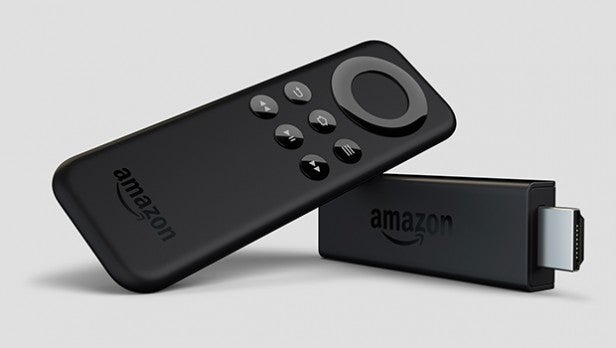
The Fire TV Stick also supports something called ‘Captive Portal’, which makes it easier to connect to Wi-Fi setups where it requires logging in through a web browser. Now, this may seem like a insignificant feature, but it actually makes the Fire TV Stick an even more awesome piece of kit.
Supporting ‘Captive Portal’ means you can connect the Fire TV to hotel Wi-Fi networks – no more overly expensive PPV films or dodgy European television, and university networks. The latter will be a big plus for students.
Amazon Fire TV Stick vs Chromecast 2 vs Roku Streaming Stick: Interface and Content
The Chromecast 2 really is a stripped-back, almost hub-like device that relies completely on your phone, tablet or laptop. You have to use apps on your mobile device to tell the Chromecast 2 which content it has to stream from the internet. That’s not necessarily a bad thing, of course, but it doesn’t make for the most welcoming living room experience.
SEE ALSO: What to watch on Netflix
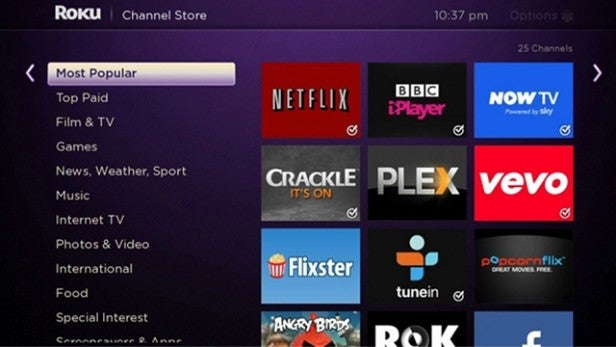
It’s the opposite approach to the Roku Streaming Stick, which is all about running apps on the device itself – the ability to cast music, videos and photos from your smartphone is a bit of an afterthought. However, there is a strong roster of some 2,000 custom apps bringing you a range of content direct to your Roku.
The Amazon Fire TV Stick is closer to the Roku approach. You’ve got a visual homescreen and you can download extra apps and services. There’s a good selection of apps for both Roku and Amazon Fire TV that covers all of the UK catch-up services: BBC, All 4, My5, and ITV Player, general streaming services, and even music apps like Spotify and TuneIn radio.
Both have neat, ordered interfaces that make finding which app you want easy and quick. Neither will win any awards for design, but they get the job done.
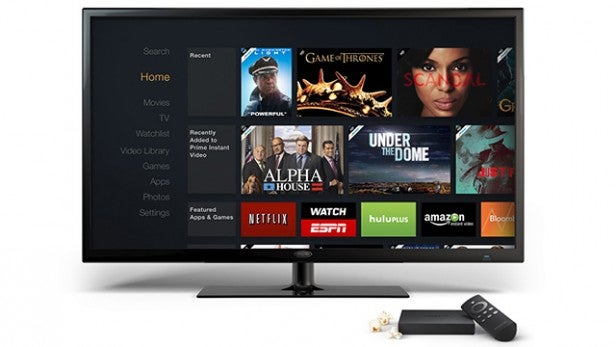
The Roku Streaming Stick has by far and away the best search system, where you can search for content through multiple apps all from one spot.
Of course, there’s an inherent problem with all these streaming devices, whether you pick up one of the cheaper sticks or even splash out on something a little more expensive. We mentioned it briefly previously, but if the main streaming service you use isn’t supported then there isn’t much point buying the products.
This has improved a fair bit of late, but there are notable omissions from two of them. Roku has added support for Amazon’s Prime Video app since we first compared these three devices, while Amazon has added ITV Hub and All4.
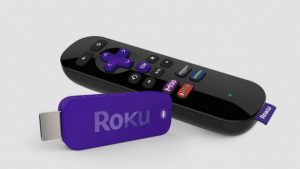
The Chromecast 2, however, still lacks Amazon’s service. There are work-arounds, but you really shouldn’t have to pursue them in this day and age.
If you’re a Prime subscriber, obviously, your best bet is Amazon’s own stick. But that lacks a Now TV app – a top source of prime US drama such as Game of Thrones and Vinyl – and it relegates Netflix to a secondary app that can’t take advantage of the universal search, ASAP, or voice control. Basically that’s three of the best features out of play.
It’s a frustrating experience. We just want something that works with all the services and treats them equally. Surely that’s not too much to ask?
Amazon Fire TV Stick vs Chromecast vs Roku Streaming Stick: Price
Price is obviously an important factor here, especially as we’re looking at the most affordable ways to make your dumb TV smart. But as they’re all similarly priced, it shouldn’t be the overriding factor in your decision. The most important aspect is finding the device that fits best with your streaming needs.
SEE ALSO: Chromecast tips and tricks

Google’s Chromecast 2 is the cheapest option here at £30 – and we’ve seen it drop to as low as £20 in the past – but then, given how bare-bones it is compared to the other two, you probably get the least bang for your buck.
At the opposite end of the scale, the Roku Streaming Stick is £49.99. That might sound dear, but do remember that it comes with a physical remote as standard, which the Chromecast 2 doesn’t.
Of course, Amazon’s Fire TV Stick does come with a remote, and it’s only a little more expensive than the Chromecast 2 at £35 (£45 with the Voice Remote). Both the Roku and Fire TV Stick do, in general, a lot more than the Chromecast 2, though.
If you’re looking for the best-value stick and aren’t stuck specifically to one streaming service, you get a lot for your money with the Amazon Fire TV Stick. Though as they’re all sub-£50, they each offer plenty of value.
Which should you buy?
If you haven’t yet invested in a way to add some connected smarts to your television, there hasn’t been a better time to do it without seeing a significant hit on your bank balance. Heck, even if your TV is already ‘smart’, these dongles offer up a much more appealing solution than the often terrible built-in software.
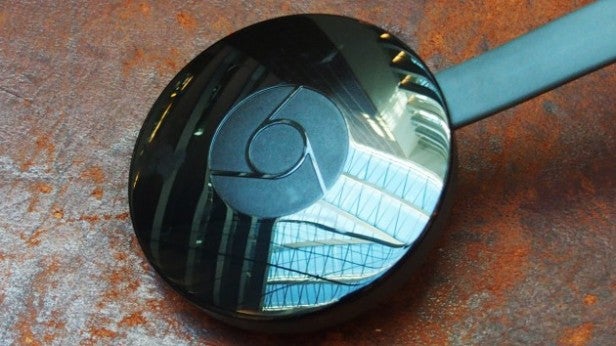
But which is best?
The current front-runner in terms of pure usability is, quite clearly in our eyes, Amazon’s Fire TV Stick. It’s easily the fastest of the three, which leads to a smooth interface, and there’s plenty of accessible content. Yes, there’s a definite bias towards the brand’s own content, but as that’s pretty good anyway we can’t complain too much.
You also have the bonus of the fantastic included remote, plus a clever app with some voice-control smarts.
If you’re not an Amazon person and don’t intend to become one, the Roku Streaming Stick does much of the same stuff, but with a more service-agnostic outlook. It has the most comprehensive content library, which is worth quite a lot. It also has a great remote-and-app combo and the universal search it utilises is definitely the best of the bunch. But it suffers from a slow interface and apps that dawdle.
As for the Chromecast 2, it has the brightest and most flexible design, the lowest price, and it packs a growing feature list that makes it a good purchase if you’re a die-hard Googler. The screen-casting features are nifty, streaming starts quickly and there are plenty of apps that are now compatible with it. But the lack of any interface makes it a clumsy solution that always requires a phone or tablet to use.
As we mentioned earlier, there isn’t a complete streaming solution out there that will suit everyone. But each offers enough to make sure there’s always something to watch. If you want to breathe new life into your television for a mere £35, you can’t go wrong with Amazon’s Fire TV Stick.
(apester:56e0078036e5105a3a8762aa)
Do you think streaming stick are the future of television? Let us know in the comments below.


